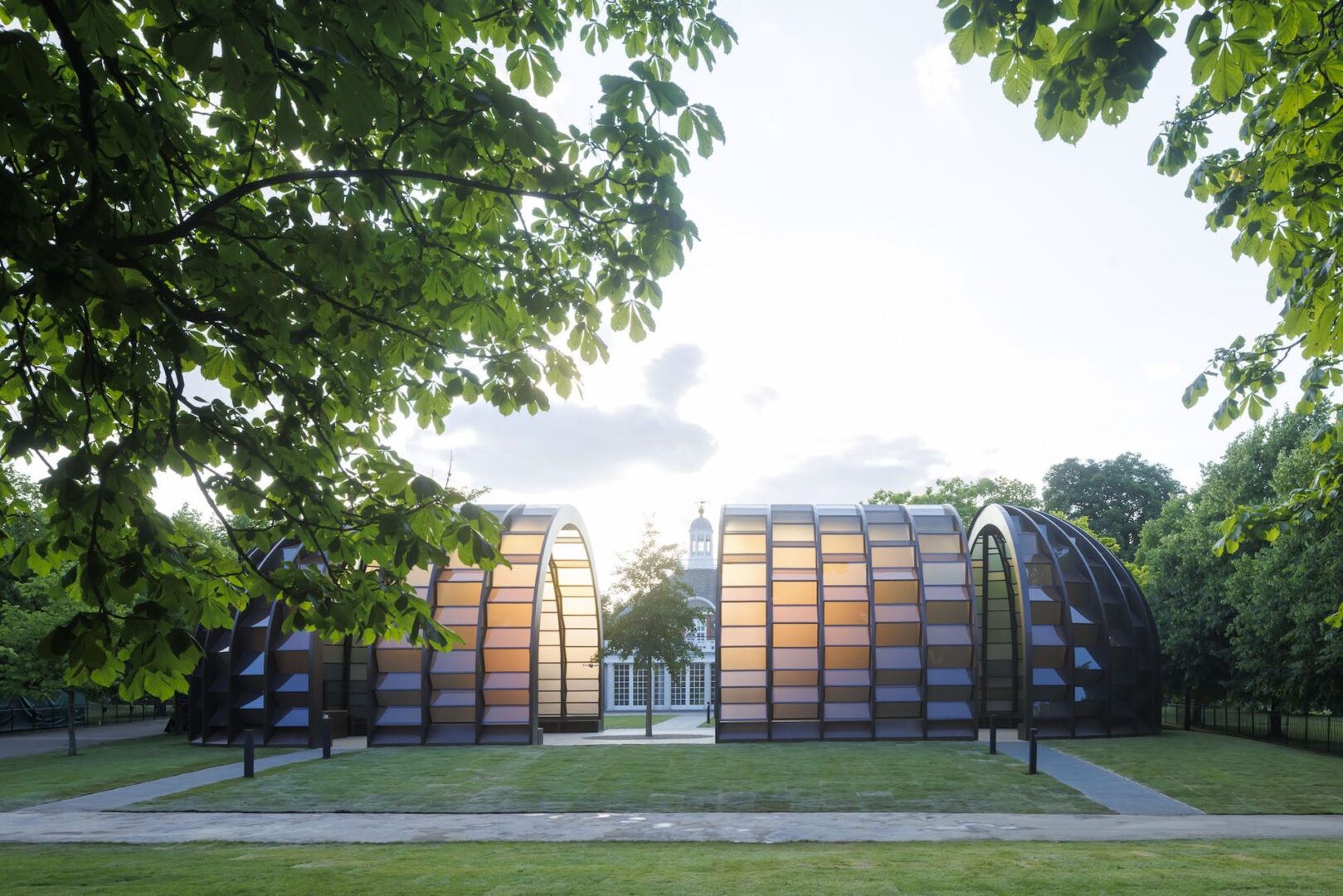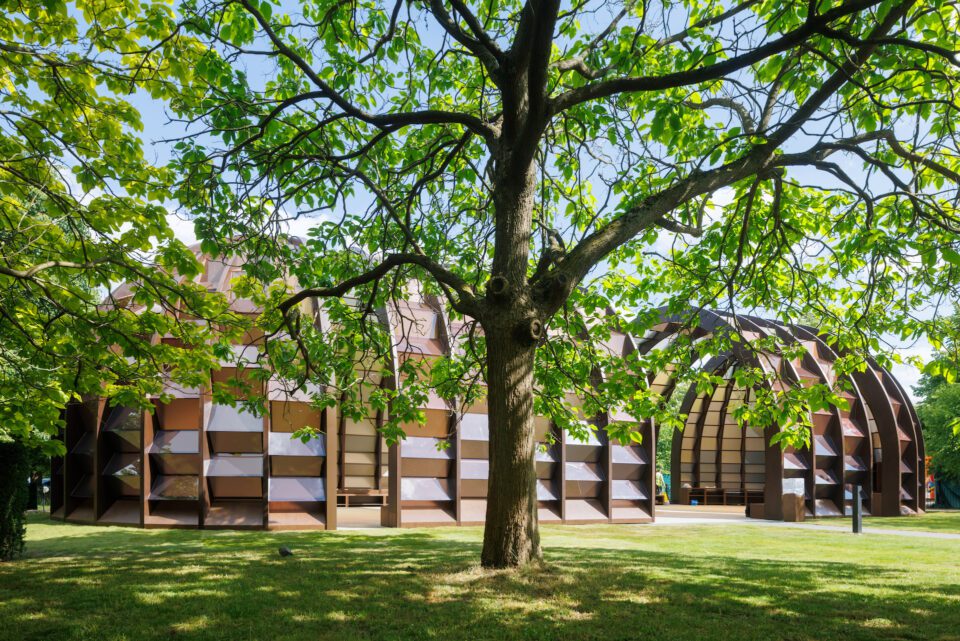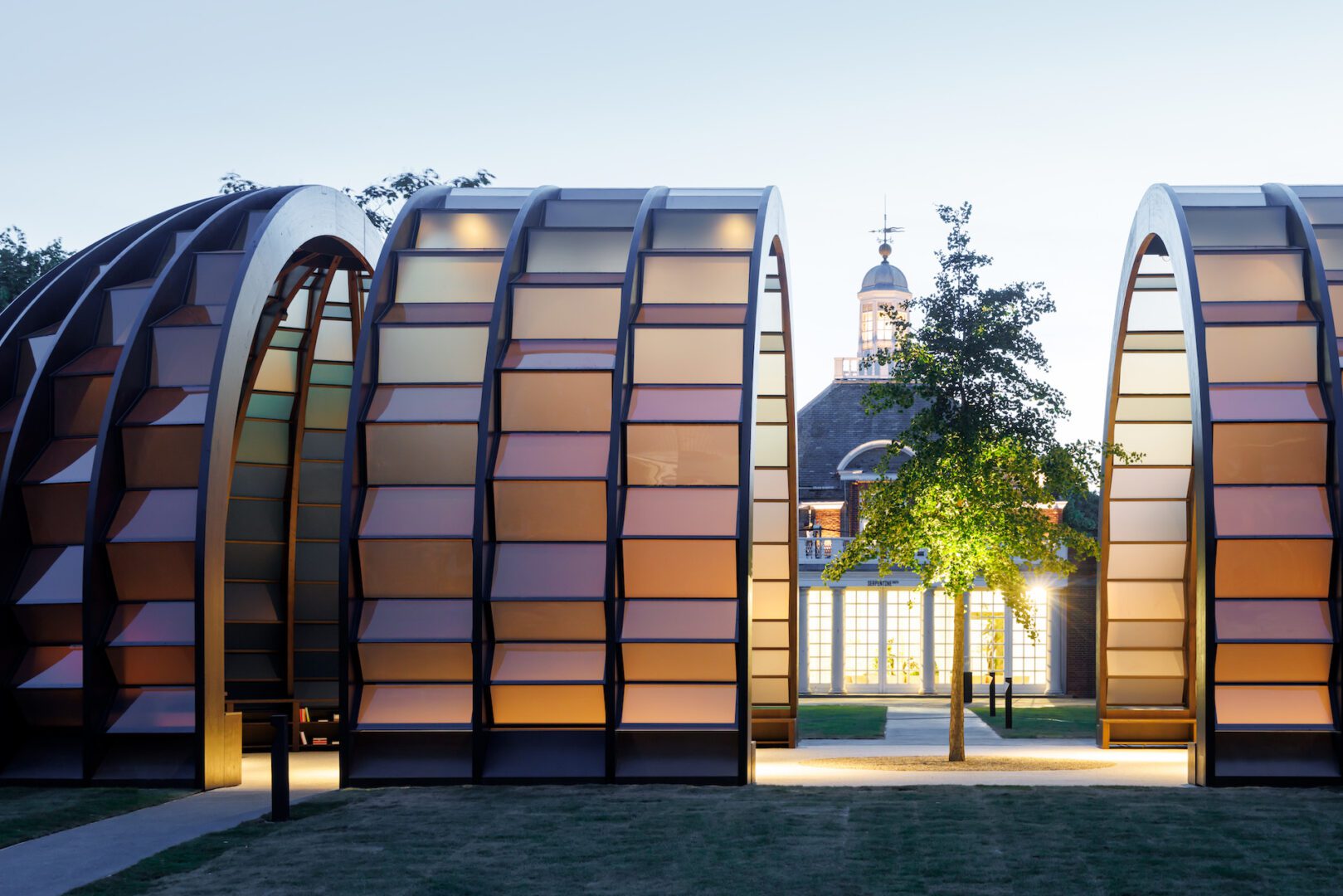The Serpentine Pavilion has long stood as one of the world’s most visible platforms for architectural experimentation, offering a space where emerging and established practitioners reimagine how we inhabit, experience and connect through built form. Now in its 25th edition, the 2025 Pavilion by Bangladeshi architect Marina Tabassum continues this trajectory with A Capsule in Time – a contemplative, luminous structure that engages deeply with the elemental forces of light, air and time.
Following in the legacy of recent Pavilions by Lina Ghotmeh (2023), Theaster Gates (2022), and Counterspace’s Sumayya Vally (2021), Tabassum’s contribution sustains a commitment to architecture as a vessel for cultural memory, dialogue and public gathering. Ghotmeh’s À table was a lightweight, radial timber structure inspired by community dining rituals, designed to foster collectivity and reflection. Gates’ Black Chapel, with its cylindrical form and meditative darkness, served as a spiritual and sonic space, honouring Black creative lineages and his own upbringing in Chicago. Vally, the youngest architect ever commissioned for the Pavilion, crafted a fragmented form drawing on the architecture of diasporic community spaces across London – churches, mosques, markets – positioning the Pavilion as a site of belonging and multiplicity. Tabassum’s A Capsule in Time enters this evolving conversation with a structure that is at once grounded and ephemeral, rooted in the shifting geographies of the Bengal delta yet resonant with global urgency. Its themes of cultural continuity, environmental fragility and spatial justice echo those animating the 2025 Venice Architecture Biennale, where architecture is positioned as a tool for planetary care and collective futures.
Situated at Serpentine South, the Pavilion’s elongated form aligns deliberately with the park’s historic bell tower, establishing a dialogue between past and present. Its design draws upon the delicacy of South Asian Shamiyana tents – light, kinetic and ephemeral – qualities that echo the transient realities of the Bengal delta where Tabassum’s practice is rooted. The Pavilion’s translucent façades filter and dapple sunlight in a manner that transforms perception, creating an immersive interplay of shadow and radiance, and inviting visitors to slow down and inhabit the moment fully.

Four wooden capsules compose the Pavilion’s structure, one of which is engineered to move, reconfiguring the space and encouraging a dynamic relationship between visitor and architecture. This kinetic aspect recalls the spirit of experimentation championed by earlier Serpentine Pavilions, such as Rem Koolhaas and Cecil Balmond’s 2006 design. Here, movement becomes not just a mechanical function but a metaphor for adaptation and connection – fundamental themes in Tabassum’s broader work.
Tabassum’s architecture embodies a philosophy that extends beyond aesthetics; it serves as a vessel of memory and cultural continuity. “The relationship between time and architecture is intriguing: between permanence and impermanence, of birth, age and ruin; architecture aspires to outlive time,” she reflects. In the Bengal delta, where rivers shift course and communities must adapt, architecture exists as a series of memories -ephemeral, yet deeply anchored in human experience. This understanding permeates the Pavilion’s conceptual framework, which embraces both the physical and the intangible.
The Pavilion also foregrounds inclusivity and community, a theme woven throughout Serpentine’s programming. By fostering a versatile space for live events, conversations, and public gatherings, A Capsule in Time seeks to unite visitors through shared experiences. “We envision various events and encounters taking place in this versatile space that unifies people through conversations and connections,” Tabassum asserts, positioning the Pavilion as a catalyst for cultural exchange and reflection under the summer sun.
Beyond the Pavilion, Marina Tabassum’s practice stands as a testament to the power of architecture as a socially and ecologically engaged discipline. Since founding Marina Tabassum Architects (MTA) in 2005, the studio has pursued projects that respond to the specificities of place, climate, and community in Bangladesh. Noteworthy among these is the Khudi Bari [Small House] project – modular dwellings designed for those inhabiting the shifting riverbeds of the Jamuna, Meghna and Teesta rivers. These homes, easily dismantled and relocated, exemplify an architecture in dialogue with environmental challenges and human resilience.

The Bait ur Rouf Mosque, another celebrated project, garnered the Aga Khan Award for Architecture in 2016 and gained recognition as one of the top 25 postwar buildings globally. Eschewing conventional mosque iconography, it emphasises space, light, and refuge – a spatial poetry that challenges norms and offers a sanctuary to a dense Dhaka neighbourhood. Such projects exemplify MTA’s commitment to an architecture that is “environmentally conscious, socially responsible and historically and culturally appropriate,” qualities that resonate powerfully within the context of the Serpentine Pavilion.
Tabassum’s global influence extends through her academic roles at institutions including Delft University of Technology and Yale University, where she held the Norman Foster Chair. Her international recognitions – ranging from the Soane Medal to the Gold Medal of the French Academy of Architecture – reflect her profound contribution to contemporary architectural discourse.
In partnership with Serpentine, the Pavilion’s presentation coincides with the 25th anniversary of this illustrious commission. The Serpentine Pavilion has historically been a site of boundary-pushing experimentation, first established in 2000 by Dame Zaha Hadid. Each year, the commission introduces groundbreaking works by architects such as Diébédo Francis Kéré, Frida Escobedo and Junya Ishigami, cultivating a lineage of innovation and cultural interrogation. Bettina Korek, Serpentine’s Chief Executive, and Artistic Director Hans Ulrich Obrist underscore the significance of Tabassum’s Pavilion as a “visionary, spiritual and social structure” that honours “connections with the Earth and celebrate[s] the spirit of community.” Its placement around a mature tree symbolically brings the park inside the architecture, blurring boundaries between built form and nature. As the Pavilion unfolds through the summer months, it will host the interdisciplinary Park Nights programme, an evolving series of live encounters across music, theatre, literature, and philosophy. This programming aligns with the Pavilion’s ethos as a gathering place for diverse expressions and perspectives, fostering dialogue and reflection within its luminous walls.
A Capsule in Time embodies an architecture attuned to the fluidity of place and memory, a structure that speaks eloquently to the enduring tension between permanence and change. Marina Tabassum’s Pavilion offers not only a physical space but a contemplative experience – an invitation to consider how architecture can encapsulate time, culture and the human spirit in dialogue with the environment. It stands as a milestone in the Serpentine Pavilion’s history and a luminous example of architecture’s capacity to foster community, resilience and poetic engagement with the world.
Serpentine Pavilion, 6 June – 26 October 2025.
Words: Anna Müller
Image Credits: Serpentine Pavilion 2025 A Capsule in Time, designed by Marina Tabassum, Marina Tabassum Architects (MTA). Exterior view. © Marina Tabassum Architects (MTA), Photo Iwan Baan, Courtesy: Serpentine.





